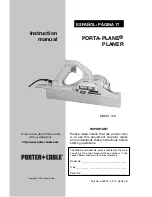
6
ADDITIONAL SPECIFIC SAFETY RULES
1. Wait for the cutter to stop before setting the tool down.
An exposed
cutter may engage the surface leading to possible loss of control and
serious injury.
2.
Use clamps or other practical way to secure and support the workpiece
to a stable platform.
Holding the work by hand or against your body is
unstable and may lead to loss of control.
3. Keep
blades
sharp.
Sharp blades will do the job better and safer.
4.
Keep hands away from cutting area.
When sawing never reach underneath
or behind the material being cut for any reason.
5. When you have finished a cut
be careful not to come into contact with the
blade. Turn off the motor immediately.
6.
EXERCISE EXTREME CAUTION WHEN BLIND CUTTING
TO BE CERTAIN THAT THERE ARE NO FOREIGN OBJECTS SUCH AS
ELECTRICAL WIRE, CONDUIT, PLUMBING PIPES, ETC., THAT MAY
COME IN CONTACT WITH THE BLADE.
7. Never hold work
in your hand, lap, or against other parts of your body
when sawing.
8.
Wear eye and hearing protection. Always use safety glasses.
Everyday
eyeglasses are NOT safety glasses. USE CERTIFIED SAFETY EQUIPMENT.
Eye protection equipment should comply with ANSI Z87.1 standards.
Hearing equipment should comply with ANSI S3.19 standards.
9.
Use of this tool can generate and disburse dust or other
airborne particles, including wood dust, crystalline silica dust and
asbestos dust.
Direct particles away from face and body. Always operate
tool in well ventilated area and provide for proper dust removal. Use dust
collection system wherever possible. Exposure to the dust may cause
serious and permanent respiratory or other injury, including silicosis (a
serious lung disease), cancer, and death. Avoid breathing the dust, and
avoid prolonged contact with dust. Allowing dust to get into your mouth
or eyes, or lay on your skin may promote absorption of harmful material.
Always use properly fitting NIOSH/OSHA approved respiratory protection
appropriate for the dust exposure, and wash exposed areas with soap and
water.







































